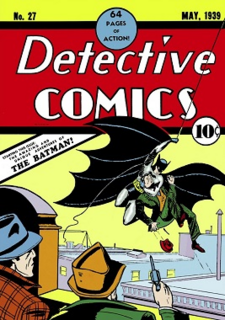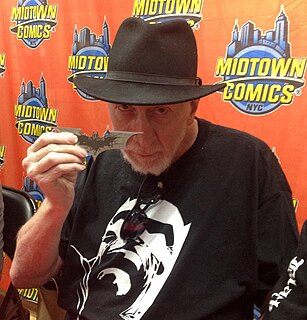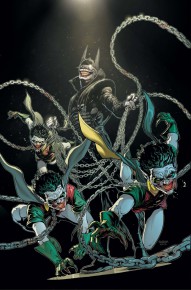
Batman is a fictional superhero appearing in American comic books published by DC Comics. The character was created by artist Bob Kane and writer Bill Finger, and first appeared in Detective Comics #27 in 1939. Originally named the "Bat-Man," the character is also referred to by such epithets as the Caped Crusader, the Dark Knight, and the World's Greatest Detective.

The Scarecrow is a fictional supervillain appearing in comic books published by DC Comics, created by Bill Finger, Bob Kane, and Jerry Robinson. The character first appeared in World's Finest Comics #3. The self-proclaimed "Master of Fear" is commonly depicted as an obsessive ex-professor of psychology in Gotham City who uses a variety of experimental drugs and toxins to exploit the fears and phobias of his victims. He is one of the most enduring enemies of the hero Batman and belongs to the collective of adversaries that make up the Dark Knight's rogues gallery.

Detective Comics is an American comic book series published by DC Comics. The first volume, published from 1937 to 2011, is best known for introducing the superhero Batman in Detective Comics #27.

Zatanna Zatara is a fictional superheroine appearing in American comic books published by DC Comics. The character was created by Gardner Fox and Murphy Anderson, and first appeared in Hawkman #4.

Batman: Legends of the Dark Knight, often simply called Legends of the Dark Knight (LotDK) is the name of several DC comic books featuring Batman. The original series launched in 1989 as the third major monthly Batman title, following the popularity of Tim Burton's Batman film. Many of the stories follow the tone of Frank Miller's Batman: Year One. The series differs from other Batman titles of the time. The creative team rotated with every story arc and the stories stood alone, unlike the inter-connected nature of other Batman comics. Initially the title ran stories contained to five issues, often with more mature topics and sensibilities than the other Batman titles. After issue #20, the number of issues for each story began to vary and occasionally tied into crossover events.

Mad Hatter is a fictional supervillain appearing in comic books published by DC Comics, commonly as an adversary of the superhero Batman. He is modeled after the Hatter from Lewis Carroll's novel Alice's Adventures in Wonderland, a character often called the "Mad Hatter" in adaptations of Carroll. Mad Hatter is depicted as a scientist who invents and uses technological mind-controlling devices to influence and manipulate the minds of his victims. He is one of Batman's most enduring enemies and belongs to the collective of adversaries that make up Batman's rogues gallery.

Killer Croc is a fictional supervillain appearing in comic books published by DC Comics, commonly as an adversary of the superhero Batman. Killer Croc belongs to the collective of adversaries that make up Batman's rogues gallery.

Batman's utility belt is a feature of Batman's costume. Similar belts are used by the various Robins, Batgirl, and other members of the Bat-family.

The Batman & Dracula trilogy consists of three American graphic novels—Batman & Dracula: Red Rain (1991), Bloodstorm (1994), and Crimson Mist (1998)—written by Doug Moench and penciled by Kelley Jones. The books were published by DC Comics as a part of its Elseworlds line of comics. Moench created the concept for the first installment and convinced Jones, of whom he was a fan, to join the project. Red Rain's eventual popularity resulted in DC commissioning sequels.

A batarang is a roughly bat-shaped throwing weapon used by the DC Comics superhero Batman. The name is a portmanteau of bat and boomerang, and was originally spelled baterang. Although they are named after boomerangs, batarangs have become more like shuriken in recent interpretations. They have since become a staple of Batman's arsenal, appearing in every major Batman television and film adaptation to date. Recent interpretations of the Dark Knight find additional motivation to use the batarang as a ranged attack and is used primarily to knock guns out of an assailant's hand.

Batman is an ongoing American comic book series featuring the DC Comics superhero Batman as its main protagonist. The character first appeared in Detective Comics #27. Batman proved to be so popular that a self-titled ongoing comic book series began publication with a cover date of Spring 1940. It was first advertised in early April 1940, one month after the first appearance of his new sidekick, Robin, the Boy Wonder. Batman comics have proven to be popular since the 1940s.

Julie Madison is a fictional character appearing in American comic books published by DC Comics, commonly in association with the superhero Batman. The character first appeared in Detective Comics #31 and was created by Gardner Fox, Bob Kane, and Sheldon Moldoff. She is best known as being Batman's first significant romantic interest.

Sheldon Moldoff was an American comics artist best known for his early work on the DC Comics characters Hawkman and Hawkgirl, and as one of Bob Kane's primary "ghost artists" on the superhero Batman. He co-created the Batman supervillains Poison Ivy, Mr. Freeze, the second Clayface, and Bat-Mite, as well as the original heroes Bat-Girl, Batwoman, and Ace the Bat-Hound. Moldoff is the sole creator of the Black Pirate. Moldoff is not to be confused with fellow Golden Age comics professional Sheldon Mayer.

The Batplane, Batwing, Batjet or Batgyro is the fictional aircraft for the DC Comics superhero Batman. The vehicle was introduced in "Batman Versus The Vampire, I", published in Detective Comics #31 in 1939, a story which saw Batman travel to continental Europe. In this issue it was referred to as the "Batgyro", and according to Les Daniels was "apparently inspired by Igor Sikorsky's first successful helicopter flight" of the same year. Initially based upon either an autogyro or helicopter, with a rotor, the Batgyro featured a bat motif at the front. The writers gave the Batgyro the ability to be "parked" in the air by Batman, hovering in such a way as to maintain its position and allow Batman to return.
Salvatore Vincent Maroni is a fictional character appearing in American comic books published by DC Comics, commonly in association with Batman. The character is portrayed as an infamous gangster in Gotham City and enemy of Batman. Maroni is most famous for disfiguring Harvey Dent, setting the stage for the young district attorney's transformation into the supervillain Two-Face.
Batman: Dark Moon Rising is a two-part comic book series written by Matt Wagner about the superhero Batman. It contains two six-part miniseries entitled Batman and the Monster Men and Batman and the Mad Monk. The two series take place after the events of Batman: Year One and before Batman: The Man Who Laughs.
Zebra-Man is the name of four DC Comics supervillains.

The Batman Who Laughs is a fictional character in DC Comics. He is a supervillain, and the evil counterpart and alternate version of Batman within the multiverse. He is depicted as a hybrid of both Batman and Batman's arch enemy Joker and is a member of the Dark Knights. His first appearance was in the crossover storyline Dark Nights: Metal, before receiving his own series and serving as the main antagonist in Batman/Superman in 2019 and DC Comics' Year of the Villain alongside Lex Luthor. He was created by Scott Snyder and Greg Capullo.

National Comics Publications and All-American Publications, two precursors to DC Comics, were formed publishing American comic books such as superhero comics starting in the 1930s. Primary Comic book anthology titles created by the company was More Fun Comics, Adventure Comics, Detective Comics, Action Comics, All-American Comics and Superman. Other companies like Quality Comics and Fawcett Comics would later be merged into DC. Quality started by introducing comic books like Feature Comics and Smash Comics.
















